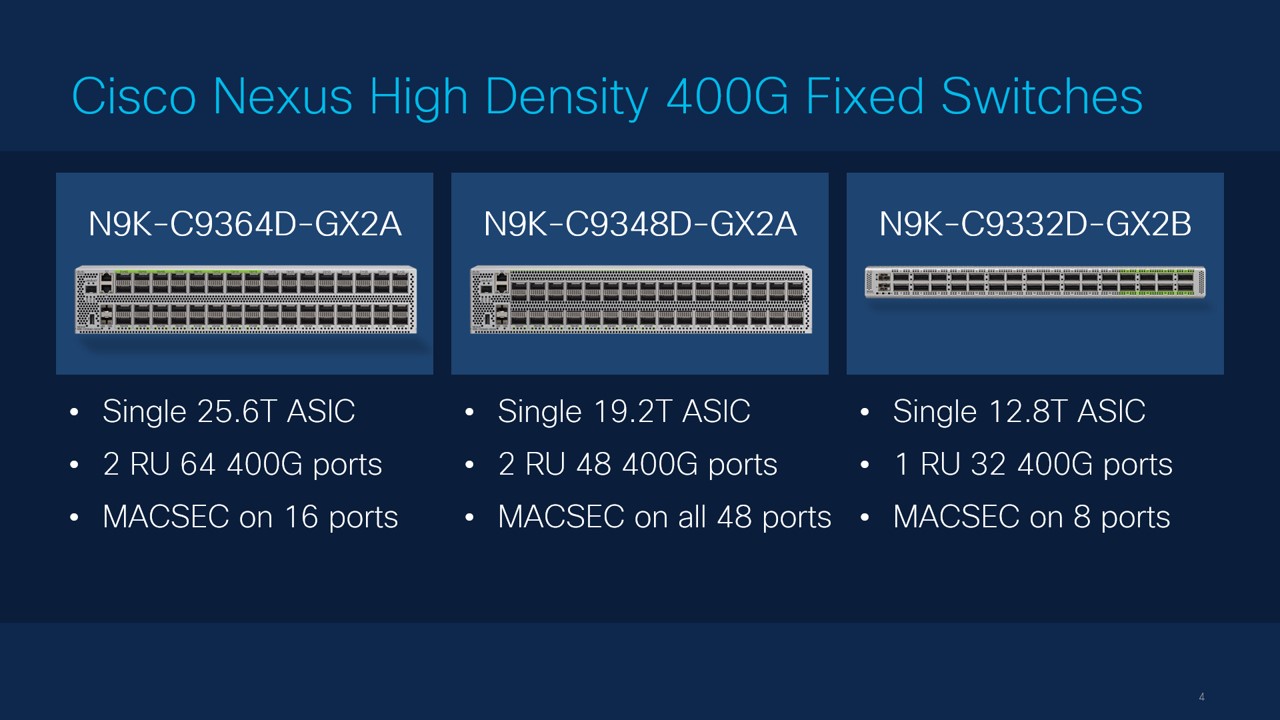In preparation for writing this blog, I took a quick trip down memory lane to 2013, the year Cisco introduced the Nexus 9500 series to the Nexus 9000 family of data center switches. These were groundbreaking products at the time, establishing industry-leading performance, scalability, and programmability benchmarks. The Nexus 9500 series introduced several state-of-the-art system innovations including the industry’s first backplane-free modular switch to provide investment protection, efficient power, and cooling. The Nexus 9508, as the highest-end model, offered high-density aggregation layer capabilities through a chassis offering eight slots of 40 Gigabit Ethernet (40G) performance.
Less than a decade later, the performance standard for Gigabit Ethernet has increased ten-fold to 400G ports and some customers already planning for 800G migration options. That has everything to do with the incredible pace and scope of technology evolution in that time.
Let’s look at an example from the financial services vertical. In 2013, just slightly over half of banks were relying on mobile apps to deliver services to their customers. Today, mobile banking apps are nearly ubiquitous and generate hundreds of billions in revenue for financial institutions including digital-only banks. Changes impacting enterprise data centers and hybrid clouds have been equally compelling since then. For instance, cloud and then multicloud adoption among enterprises has increased dramatically with more than 80 percent of the companies that 451 Research surveyed saying that they have a hybrid strategy in place. More than half of these companies say that they have adopted two or more public clouds as part of their day-to-day IT operations.
Additionally, microservices architecture is clearly the preferred model for app development today, which has created a diversity of workload deployment models including on-prem, virtual machines, containers, bare metal, serverless, etc. In turn, this explosion of workloads has created more traffic within and among data centers and clouds than ever and, as always, it is the role of the network to serve as the “freeway” and the backplane. Further, it’s important to understand that these trends are enabled by the speed and scale of bandwidth evolution including 400G technology, which is expected to increase 224-fold (from 2018) by 2026, while 800G technology will see an 84-fold uptick, according to the Dell’Oro Group.
New Nexus 9000 400G Performance Options
To ensure that our customers can stay ahead of these cloud networking realties, we are introducing new Nexus 9000 400G performance options at scale with a migration path to 800G performance in the near future. Here’s a quick summary of what’s new:
Nexus 9800
Our new flagship modular data center switch product family with 14.4Tbps fully encrypted bandwidth per slot. With a highly scalable architecture and backplane, the Nexus 9800 will enable customers to migrate to 800G performance seamlessly as their performance requirements grow over time.
Nexus 9400
A new compact, modular chassis that offers up to 64 ports of 400G line-rate performance (or up to 128 ports of 100/200G performance). The Nexus 9400 is an ideal solution for customers who want the flexibility of modular line cards in a 4 RU compact form factor leveraging a single 25.6Tbps industry leading Cisco ASIC. Use cases include compact spine designs and efficient multi-plane scale-out fabric designs enabling gradual transition from 100G to 200G to 400G links.
Nexus 9300
Cisco is adding two new high-performance fixed data center switches to its existing 400G switch line up. The Nexus 9364D is a 2RU industry leading density, 64p 400G 2RU switch, supporting line rate 400G encryption on 16ports. The Nexus 9348D is a 2RU 48p 400G 2RU switch supporting line rate 400G encryption on all 48 ports. These switches are ideal for both leaf and spine roles in customer fabric designs. The integrated line rate encryption supports a broad range of multi-layer security architectures. The Nexus 9332D is shipping today. The Nexus 9348D and Nexus 9364D will be available in June 2022.
With these additions, the Nexus 9000 family now offers a full breadth of 400G options that can meet the data center and hybrid cloud needs of enterprises and service providers of all sizes. We are delivering density in form factors needed to operate efficiently in space-constrained facilities such as edge data centers. We are delivering the performance and low-latency necessary to run the most data-intensive applications including AI/ML, storage over IP, rich media (e.g., video rendering), and advanced analytics/telemetry processing. And we are delivering on significant advancements in power and cooling efficiency, ideal for more sustainable data center and hybrid cloud operations.
Next blog: Breakthroughs in management and operations with Nexus Cloud
The hardware innovations are only a part of the full scope of the Nexus portfolio evolution. In my next blog, I’ll discuss the compelling capabilities of Nexus Cloud that is empowering customers with cloud agility, automation, intelligence, and end-to-end visibility in ways that simplify their operations and accelerate their time to value.
Take a moment to learn more about the
benefits and capabilities of 400G networking
Also, please check out the blog from Ish Limkakeng, SVP of Cisco Cloud Networking:
Introducing Nexus Cloud, Agility of Cloud, Power of Nexus
It provides a good overview of the Nexus announcements we’re making at Cisco Live! this week.




CONNECT WITH US